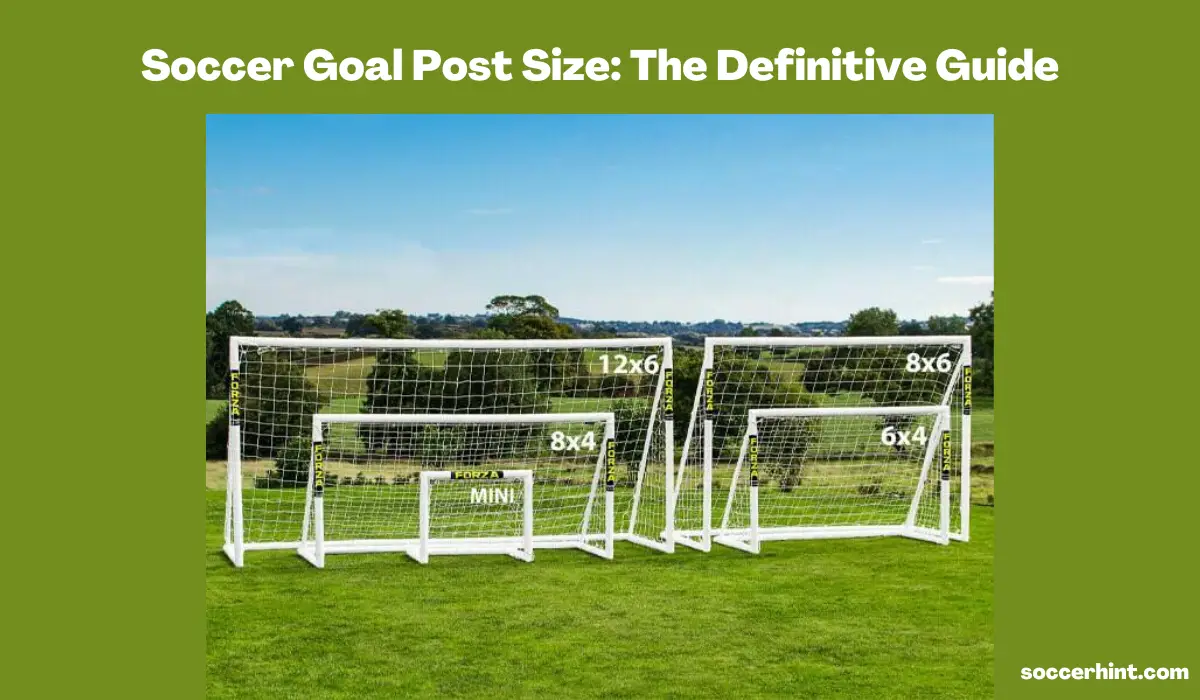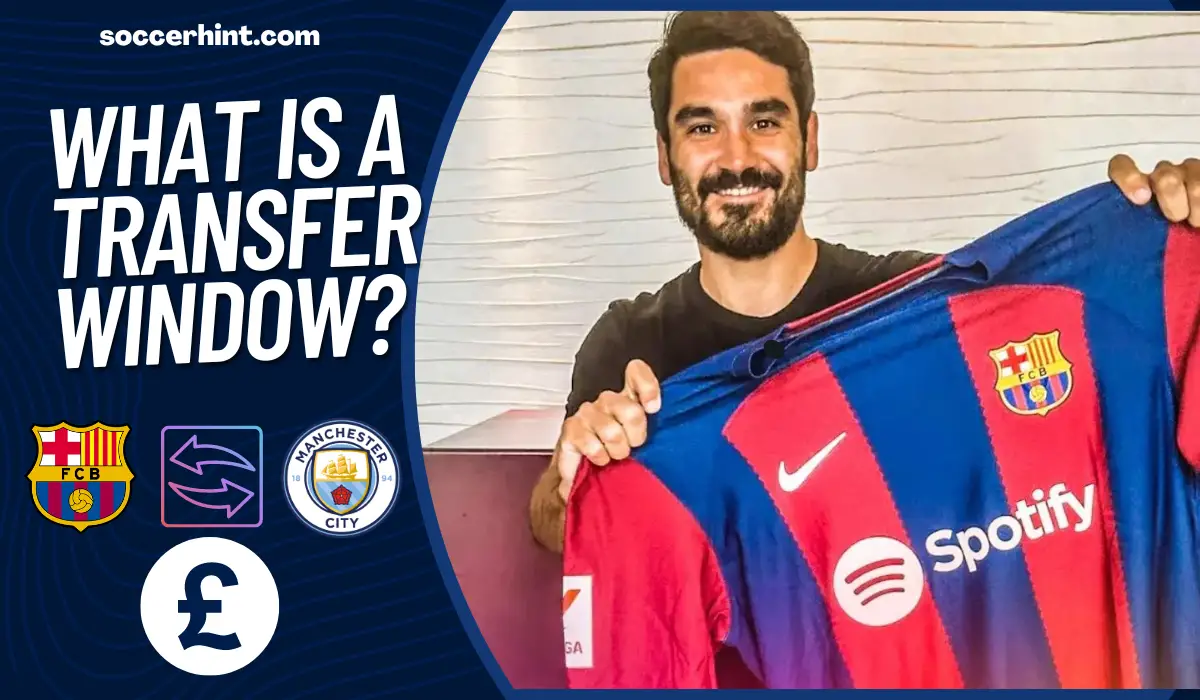In the world of soccer, goal post size plays a crucial role in shaping the game. Understanding the dimensions of soccer goal posts is essential for players, coaches, and fans alike. In this definitive guide, SoccerHint delves into the intricacies of soccer goal post size, exploring measurements in both feet and meters.
From standard dimensions to variations across different formats, join us as we uncover the secrets behind the perfect goal post size in the beautiful game of soccer.
What Is Soccer Goal Post?
A soccer goal post is a structure used in the game of soccer (football) to mark the scoring area for each team. It consists of two vertical posts connected by a horizontal crossbar.
The goal post is positioned at each end of the playing field, and its purpose is to define the target area where players aim to score goals by propelling the ball past the opposing team’s goalkeeper and into the net.
The goal post serves as a visual and physical boundary, providing a clear indication of where goals can be scored.
Factors Affecting Goal Post Size
Several factors come into play when determining the appropriate size of soccer goal posts. These factors influence goal post dimensions across different levels of the game, including professional stadiums and recreational fields.
A. Historical evolution of goal post dimensions
The historical evolution of soccer has seen changes in goal post dimensions. Early versions of the game had varying goal post sizes, often reflecting the available materials and local customs. Over time, standardization efforts aimed to create consistency in goal post dimensions to ensure fairness and uniformity in gameplay.
B. FIFA regulations and guidelines
FIFA, the international governing body of soccer, provides regulations and guidelines that influence goal post sizes. These regulations are designed to maintain consistency and fairness in the game. FIFA sets specific measurements for goal post height and width, ensuring a standardized target for players and goalkeepers. Professional competitions worldwide follow these regulations.
C. Considerations for professional stadiums and recreational fields
Goal post size considerations vary depending on the venue and purpose. In professional stadiums, FIFA often set the standard dimensions of goal posts. These standards ensure that players are presented with a consistent challenge in scoring goals.
On the other hand, recreational fields may have more flexibility in goal post sizes. It takes into account factors such as the age group of players and available space. Youth leagues or smaller-sided games may utilize smaller goal posts to suit the physical abilities and skill levels of young players.
D. Other Factors
Factors like player safety, field dimensions, and the overall aesthetics of the game also impact goal post size decisions. Safety measures, such as anchoring and stability of the goal posts, are essential to prevent accidents. Furthermore, the choice of materials and construction techniques can affect the durability and longevity of the goal posts.
Soccer Goal Post Size in Feet
A. Standard goal post size in feet
- International standard dimensions: The standard goal post size in professional soccer is 8 feet in height and 24 feet in width. These dimensions are widely recognized and followed in international competitions such as the FIFA World Cup and major leagues around the world.
- Variations in different leagues and competitions: While the international standard dimensions are commonly used, some leagues and competitions may have slight variations in goal post sizes. For instance, certain youth leagues or lower divisions might use slightly smaller goal posts to accommodate different skill levels and field sizes.
B. Youth goal post size in feet
- Age-specific goal post dimensions: It is crucial to adjust goal post sizes for different age groups in youth soccer to ensure appropriate gameplay and skill development. Here are general guidelines for youth goal post sizes in feet:
- Under 6 to Under 8: 4 feet in height and 6 feet in width.
- Under 9 to Under 10: 6.5 feet in height and 12 feet in width.
- Under 11 to Under 12: 7 feet in height and 21 feet in width.
- Under 13 to Under 17: 8 feet in height and 24 feet in width.
- Safety considerations for young players: Safety should be a top priority when determining goal post sizes for youth soccer. Smaller goal posts for younger age groups not only accommodate their physical capabilities but also reduce the risk of injuries. Additionally, ensuring proper anchoring and stability of the goal posts is essential to prevent accidents during games and training sessions.
Soccer Goal Post Size in Meters
When discussing soccer goal post size, it’s important to understand the measurements in meters, as they are widely used in international soccer. To convert goal post dimensions from feet to meters, a conversion factor must be applied. One foot is approximately equal to 0.3048 meters. By multiplying the measurement in feet by 0.3048, we can obtain the corresponding measurement in meters.
The international metric standards for soccer goal post size, recognized by FIFA, specify that the goal posts is 2.44 meters in height and 7.32 meters in width. These dimensions provide a consistent and standardized approach to goal post sizes in professional soccer competitions worldwide. The 2.44-meter height ensures a significant vertical space for players to aim their shots, while the 7.32-meter width allows for a challenging target for goalkeepers to defend.
Other Goal Post Size Variation and Formats
Goal post sizes can vary across different formats of soccer, adapting to the specific requirements and dimensions of each game. Don’t forget; the standard (11 vs 11) goal post size is typically 8 feet (2.44 meters) in height and 24 feet (7.32 meters) in width.
Let’s explore how goal post sizes differ in other formats:
A. Indoor soccer (futsal, indoor 5-a-side)
Indoor soccer formats like futsal and indoor 5-a-side have their own goal post size specifications. Futsal goal posts are smaller than outdoor soccer goal posts, with dimensions of 6.56 feet (2 meters) in height and 9.84 feet (3 meters) in width. The smaller goal size in futsal allows for faster-paced, skill-oriented gameplay. Indoor 5-a-side soccer goal post sizes may vary. But they are generally smaller than outdoor goals to suit the smaller playing area.
B. Small-sided games (7-a-side, 9-a-side)
Small-sided games, such as 7-a-side and 9-a-side soccer, often feature adjusted goal post sizes. The specific dimensions may vary depending on the age group and regulations of the league or competition. Generally, the goal posts used in small-sided games are smaller than those in traditional 11-a-side soccer. This adaptation accommodates the smaller field size and promotes an appropriate level of challenge for the players.
C. Beach soccer
Beach soccer, played on sandy beaches, also has its unique goal post size. The goal posts used in beach soccer are typically smaller than those in traditional outdoor soccer.
The dimensions often vary but are commonly around 5 feet (1.5 meters) in height and 10 feet (3 meters) in width. The smaller goal size in beach soccer adds excitement to the game and allows for different playing techniques due to the unique beach environment.
Conclusion
In conclusion, the standard soccer goal post dimension of 8 feet (2.44 meters) in height and 24 feet (7.32 meters) in width stands as the recognized measurement for professional outdoor 11-a-side matches.
However, goal post sizes vary across different formats to adapt to specific playing environments and cater to the needs of players at various levels.
Whether it’s the smaller dimensions in indoor soccer, the adjusted sizes for small-sided games, or the unique requirements of beach soccer, goal post dimensions are carefully chosen to ensure fairness, challenge, and an enjoyable soccer experience.
Understanding and adhering to the appropriate soccer goal post sizes contribute to the integrity of the game, player safety, and the overall development of the sport.





